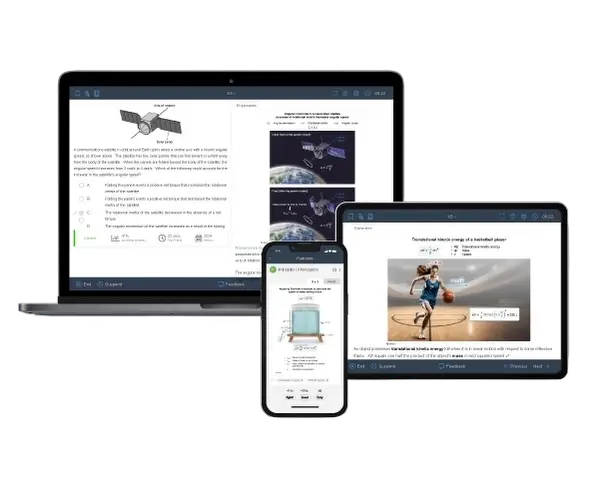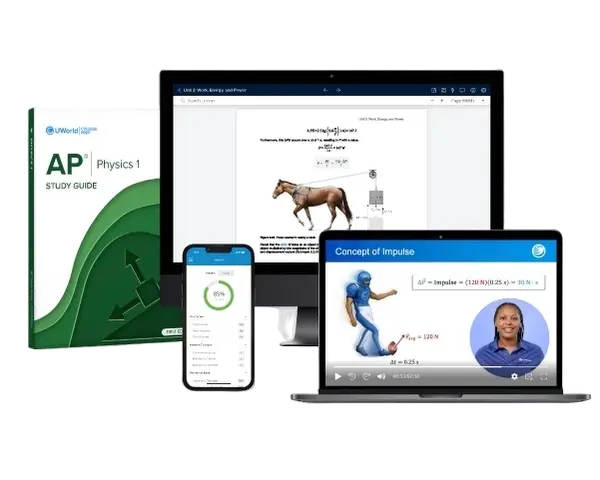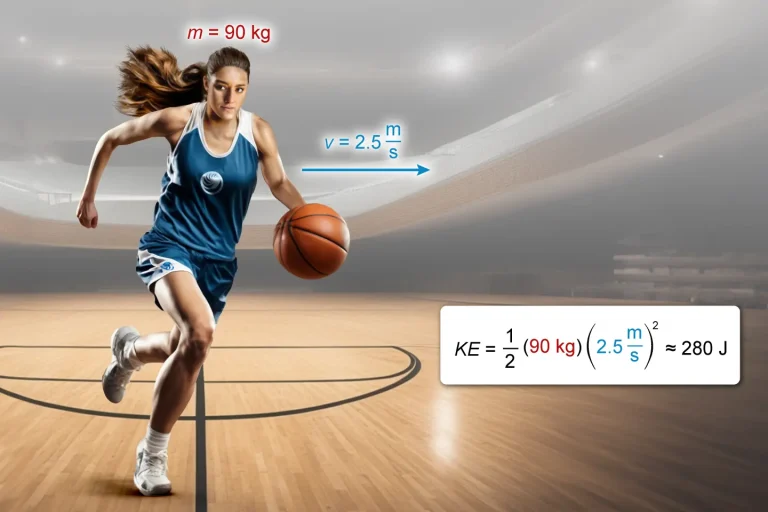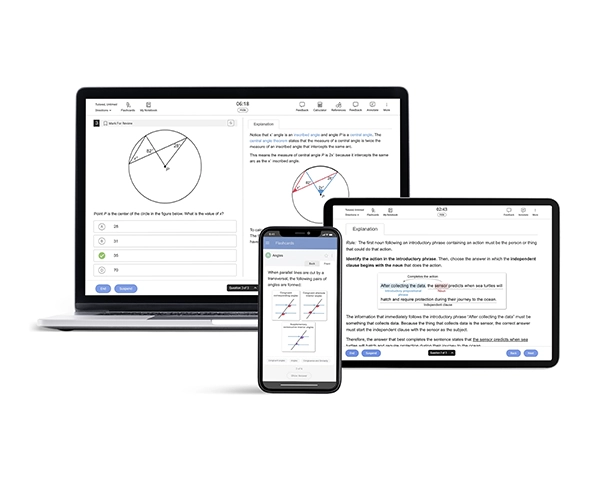The free-response (FRQ) section of the AP® Physics 1 exam consists of 4 questions worth 50% of your score. You'll be required to draw graphs, show your calculations, and provide concise but thorough responses to earn full points.
Here are tips on how to tackle FRQs, explanations and meanings of common task verbs used, and an overview of each type you will encounter on the AP Physics 1 exam.
FRQ Types on the AP Physics 1 Exam
The exam consists of 4 free-response questions, each testing different skills2:
Mathematical Routines (MR)
- Points: 10
- Skills/Science Practices: 1.A, 1.C, 2.A, 2.B, 3.B, 3.C
- Description: Requires you to use mathematical methods to analyze a scenario, derive relationships, and make predictions. You'll need to justify your claims with appropriate physics concepts and provide a logical and sequential application of these concepts.
Translation Between Representations (TBR)
- Points: 12
- Skills/Science Practices: 1.A, 1.C, 2.A, 2.D, 3.B, 3.C
- Description: Assesses your ability to connect different representations (graphs, diagrams, equations) of a scenario. You'll create visual representations, derive equations, and make predictions based on these. Justifications should use reasoning consistent with your analysis.
Experimental Design and Analysis (LAB)
- Points: 10
- Skills/Science Practices: 1.B, 2.B, 2.D, 3.A
- Description: Tests your ability to design experiments, describe procedures, and analyze data. You'll propose methods for data collection and analyze given data through graphs or other means to draw conclusions.
Qualitative/Quantitative Translation (QQT)
- Points: 8
- Skills/Science Practices: 2.A, 2.D, 3.B, 3.C
- Description: Requires you to connect qualitative descriptions of a scenario with quantitative reasoning. You'll justify claims, derive equations, and predict how scenario changes would affect the outcome.
Tips for Writing FRQ Responses
Your ability to approach the questions logically and efficiently use time will greatly impact your success in this section of the AP Physics 1 exam.
Budget Your Time Wisely
You have 1 hour and 40 minutes to complete the AP Physics 1 FRQ exam section. The key to efficiently using your time is to start by answering the questions you feel best equipped to handle. Doing this can earn you the most points in the shortest time. You do not need to answer the questions in a particular order.
The AP Physics 1 exam has 4 free-response questions: Mathematical Routines, Translation Between Representations, Experimental Design and Analysis, and Qualitative/Quantitative Translation. These questions vary in format and may include calculations, diagrams, experimental analysis, and connecting multiple scenario representations.
- If you get stuck writing an answer to part of a question, skip to the next part or next question. Return to the unfinished question if you have time at the end of the exam.
- If you finish answering all the questions with time to spare, go back and read your responses. Double-check that you have answered all parts of each question.
Pro Tip: Our timed AP Physics 1 practice exams can help you simulate the actual test environment so you can perfect your time management skills before exam day.
Be Concise, But Write in Complete Sentences
If you want to score well on the AP Physics 1 free response questions, focus on answering the main question as clearly as possible. Don't worry about writing an answer to make your English teacher proud. Instead, demonstrate to the reader that you understand the concept being tested. For questions requiring paragraph-length responses, you need to write in complete sentences. Outlines and bulleted lists are not acceptable. You must demonstrate a conceptual understanding of the topic to score all available points.
- Address the question directly. Do not restate the question or write an introduction.
- After you have answered the question, stop writing. Writing redundant information could risk contradicting something you said that would have otherwise earned a point.
- If you don't know how to spell a word you want to use, just do your best. You earn points by demonstrating your conceptual understanding, not your spelling. If you cannot recall a particular term, try to explain the idea as best you can.
- If the question asks you to “briefly” explain something, keep your answer short and to the point.
Understand How FRQs are Scored
A team of AP Physics 1 teachers and college instructors are carefully trained to use specific scoring standards when assigning points for correct answers. Points are awarded by the reader when responses contain specific details, as described in the scoring standards1. The key to earning maximum points is positively demonstrating your understanding of each part of the question.
- Write your responses as if you are explaining the concepts to someone who doesn't know much about physics. This way, you'll explain your answer with the scientific laws and reasoning to support it.
- The readers are not allowed to award points unless they can positively determine that you have met the criteria as explained in the scoring standards. So, write legibly (using a pencil or a pen with dark blue or black ink) only in the space provided for the answer. Readers will ignore any responses you cross out. If you do not want something scored, or if you make a mistake, just mark a line through the designated part of the response. Don't waste time by trying to erase them completely.
- Complete your thoughts as you explain a concept. Do not leave out anything essential to demonstrate your understanding. For example, if you were asked to explain the result of an experiment, you would need to list all the relevant factors and the associated reasoning for why each factor affects the experiment. Simply writing the list may not be sufficient to earn points.
- Incorrect answers have no penalty on your overall score. Therefore, even if you are unsure, attempt to answer all questions as time permits. You will likely know something about the topics assessed, and there are multiple ways to earn a point for a particular part of a question. The only way to definitely earn 0 points is by not attempting to answer the question.

Common Task Verbs and Their Meanings
Several task verbs are commonly used in AP Physics 1 FRQs2. To write an effective answer, you need to know the expectations associated with the wording of each question. Some task verbs are not commonly used terms, and some overlap somewhat with others. Understanding this terminology will help you earn the maximum points for each question. Our study guide gives detailed explanations of each task verb so you're fully prepared to respond in the best way possible.
Let's look at the most common task verbs used in FRQs:
Calculate
You will apply mathematical steps (basic algebra, formulas from the provided AP Physics 1 formula and equation sheet) to arrive at a final calculated answer — including correct units and significant figures. This may also be phrased as “what is?”
Example: Using Figure 1, calculate the average rate of change in growth in the control group.
- Remember to double-check your calculations, either in your head or on your calculator.
- Make sure your final answer is easy for your reader to pick out. You can achieve this by boxing your answer.
Compare
You will describe or explain aspects that are similar and/or different.
Example: Compare the change in potential energy of the ball-Earth system to the change in kinetic energy of the ball-only system while the ball is in the air.
- Find relationships between the 2 things that are being compared.
- Use physical laws to reinforce your claims regarding the relationship between them.
Derive
You will use equations or laws and carry out mathematical steps in a proper sequence to produce a final answer.
Example: Derive an equation that represents the position x of the car as a function of time t.
- Be sure to include all initial equations and/or data that are used to derive the final equation.
- Show each step of the derivation, and be sure to identify variables as needed.
Describe
You will provide relevant information about a particular topic.
Example: Describe the immediate motion of the electron after it is released.
- Be sure to focus on simply describing the topic provided first.
- Reasoning that supports your description may not be needed. It should only be added after your basic description is written.
Determine
You will come to a decision or conclusion after evaluating the given information in the question. These types of questions test your critical thinking skills.
Example: Using the experimental data, determine the net force acting on the cart.
- You should provide reasoning or evidence to show how you arrived at your determination.
Draw
You will create a diagram or schematic that illustrates relationships, depicts physical objects, or shows consistency between different types of representation. Labels may or may not be required.
Example: Draw a free-body diagram showing the forces acting on a block sliding down an inclined plane.
- Make sure your diagram is clear and shows all relevant forces, including labels if necessary.
Estimate
You will provide an approximate value based on logical reasoning or known information. This may involve rounding, using simplified calculations, or comparing magnitudes.
Example: Estimate the time it will take for the ball to hit the ground after being released from a height of 2 meters.
- You do not need to show steps in calculations when estimating.
Indicate
You will provide specific information about a particular aspect without elaborating or explaining further.
Example: Indicate the direction of an object's velocity at the highest point in its trajectory.
- Keep your answer concise, focusing on providing the correct information.
Justify
You will need to provide evidence to show that a claim is true.
Example: Justify the equation derived by the students.
- You may also need to provide reasoning to explain how your evidence supports, defends, or modifies the claim.
- This typically requires the use of data provided in the question.
Label
You will need to add labels to a visual representation to indicate units, scales, or various other components.
Example: On the diagram, label the center of mass.
- It will be really important to read through the given information and quickly analyze the type of visual representation in front of you. This will help you to write the proper labels.
Plot
You will need to add data points to a graph that already shows the scale or add data points along with the scale/units needed for a graph.
Example: Plot the data points on the grid.
- Ensure consistency between data representations of different types (e.g. data table and graph). You may be asked to plot using the table's information.
Rank
You will arrange a series of items or values in order of magnitude or size.
Example: Rank the forces acting on the car from largest to smallest.
- Be sure to justify your ranking based on physical principles or evidence when required.
Sketch
You will create a simple, clear diagram to represent a physical scenario or concept. This may include graphs, force diagrams, or motion paths.
Example: Sketch a graph that represents the speed of the ball.
- Ensure your sketch is clear, easy to read, and has all the necessary information to answer the question. Remember to label your axes properly.
Verify
You will confirm that the necessary conditions are met to explain why a particular scientific idea applies in a given circumstance. This term can also be used when you are asked to use data, tests, or other details/information to confirm a hypothesis.
Example: Verify that the linear momentum was conserved during the collision.
- You may need to provide a list of information or state key details that make your explanation the correct answer.
By using resources such as UWorld's AP Physics 1 online course, you can reinforce your understanding and approach the exam with confidence. Remember that thorough preparation is the key to excelling on the AP Physics 1 FRQ exam section.

Frequently Asked Questions (FAQs)
How many FRQs are on the AP Physics 1 Exam?
The AP Physics 1 exam includes 4 free-response questions that account for 50% of the exam score.
How are AP Physics 1 FRQs graded?
A team of high school AP Physics teachers and college physics professors grade the exam by hand. College Board® provides scoring guidelines to inform readers what to look for, which tend to be consistent from year to year. If there is a grading difference between 2 graders, a dedicated head reader makes the final decision.
How long is the FRQ section of the AP Physics 1 Exam?
The AP Physics 1 exam lasts 3 hours total, but the FRQ section is 1 hour and 40 minutes.
Where can I get FRQs from past AP Physics 1 exams?
You can access released questions from AP Physics 1 past exams on the AP Central website.
References
- AP Exam Administration Scoring Guidelines - AP Physics 1. (2024). apcentral.collegeboard.org. Retrieved from https://apcentral.collegeboard.org/media/pdf/ap24-sg-physics-1.pdf
- AP Physics 1: Course and Exam Description. (2024, Fall). apcentral.collegeboard.org. Retrieved from https://apcentral.collegeboard.org/media/pdf/ap-physics-1-course-and-exam-description.pdf
Read More About the AP Physics 1 Exam
Master AP Physics 1 multiple-choice questions with expert strategies! Boost accuracy, confidence, and performance using our resources for exam day success.
How to Study for AP Physics 1Ace AP Physics 1 with our step-by-step guide! Discover expert tips, strategies, and top resources to master concepts and score a 5 effortlessly on the exam.
AP Physics 1 Exam FormatUncover the complete AP Physics 1 exam structure, including question types, topic weights, scoring details, and strategies to prepare effectively with confidence.
Best AP Physics 1 Review Course ComparisonWondering which AP Physics 1 prep course is the best? Explore this detailed review of top courses to find the perfect fit for your exam prep and achieve success.
Best AP Physics 1 Study Guide ComparisonCompare Kaplan, Barron's, Princeton Review, and UWorld to find the best guide. Discover strategies, features, and resources to help you ace AP Physics 1.
How to Self-Study for AP Physics 1Self-study AP Physics 1 with our detailed plan! Gain expert tips, essential tools, and proven strategies to confidently prepare and ace the exam with success.



